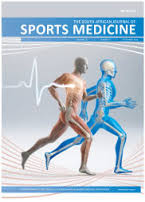Effects of wearable resistance load placement on neuromuscular activity and stride kinematics: A preliminary study
DOI:
https://doi.org/10.17159/2078-516X/2022/v34i1a13102Abstract
Background: Wearable resistance (WR) training is a modality that allows athletes to perform loaded sport-specific movements to develop force and power outputs. The acute responses by which WR works is still relatively unknown, and the effects of WR load and location of the load has not yet been examined.
Objectives: To investigate the acute neuromuscular and stride characteristic responses to different wearable resistance (WR) loads and placements on the calf muscles during high-speed running.
Methods: Ten well-trained subjects completed a workout of ten sets of three 10s runs at 18km.h-1 (20s of rest between runs and one min between sets). Five conditions were tested: (1) unloaded control, (2) bilateral 0.75 vs. 1.5% body mass (BM) loading on the distal posterior calf, (3) bilateral proximal vs. distal loading of 1.5% BM positioned posteriorly, (4) bilateral anterior vs. posterior loading of 1.5% BM positioned distally, (5) unilateral loading of 1.5% BM on the distal posterior calf. Data were collected using Electromyography (EMG) and back-mounted GPS-embedded accelerometers. Magnitude of differences of within athlete and between muscle comparisons were calculated using effect sizes (ES) ± 90% confidence limits (CL).
Results: No substantial differences in accelerometry data were observed between any of the loaded conditions and the control. EMG activity was lower for proximal loading compared to the control for the gluteus maximus (ES±90%CL; -0.72±0.41), vastus lateralis (-0.89±0.47) and vastus medialis (VM) (-0.97±0.46). Anterior loading induced substantially lower EMG activity for the semitendinosus (-0.70±0.48) and VM (-0.64±0.39) muscles compared with the control. EMG activity of the VM (-0.73±0.46) muscle was also substantially lower for posterior loading compared to the control. Unilateral loading induced no substantial differences in EMG activity between the loaded and unloaded legs.
Conclusion: This preliminary study has provided a rationale for the performance of further investigations into the effects of WR lower limb loading on stride characteristics and EMG activity from a chronic standpoint using a larger population.
Downloads
Downloads
Published
Issue
Section
License
Copyright (c) 2022 South African Journal of Sports Medicine

This work is licensed under a Creative Commons Attribution 4.0 International License.
The South African Journal of Sports Medicine reserves copyright of the material published. The work is licensed under a Creative Commons Attribution 4.0 (CC BY 4.0) International License. Material submitted for publication in the South African Journal of Sports Medicine is accepted provided it has not been published elsewhere. The South African Journal of Sports Medicine does not hold itself responsible for statements made by the authors.
How to Cite
- Abstract 481
- PDF 548






.png)